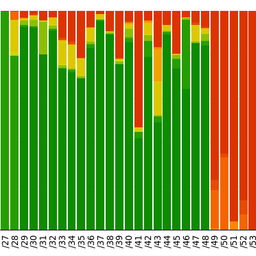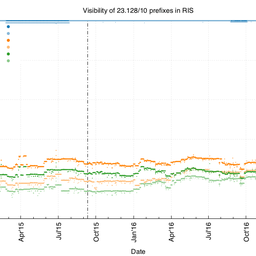Under ARIN's Number Resource Policy Manual (NRPM) Section 4.10, the IPv4 address block 23.128/10 is reserved for allocations and assignments dedicated to facilitate IPv6 deployment. The maximum allocation size is a /24; the minimum allocation size is a /28. There has been much discussion on the NANOG mailing list about the usability/routability of prefixes longer than a /24. In order to try to provide some additional data on this topic, the RIPE NCC has requested a small block of address space from the reserved /10 to test these types of prefixes.
To test longer-than-/24 prefixes, we announced six prefixes out of the 23.128/10 address space from the RIPE RIS AS ( AS12654 ), using experimental allocations we got from ARIN. We initially thought we'd just announce 3 prefixes (/24,/25 and /28), but guided by a suggestion from Job Snijders , we created a double setup with one set of prefixes having a route object, and the other set deliberately not having a route object. This was to quantify the effect of having a route object for these types of prefixes. Table 1 shows the prefixes used for this experiment.
| Prefix | Pingable IP | Route object? |
| 23.128.24.0/24 | 23.128.24.1 | yes |
| 23.128.25.0/25 | 23.128.25.1 | yes |
| 23.128.25.240/28 | 23.128.25.241 | yes |
| 23.128.124.0/24 | 23.128.124.1 | no |
| 23.128.125.0/25 | 23.128.125.1 | no |
| 23.128.125.240/28 | 23.128.125.241 | no |
Table 1: Overview of prefixes used for this experiment
We intend to update this page with results from the experiment, with views from both the control plane (RIPE RIS) and the data plane (RIPE Atlas). Apart from these results, everybody can test the reachability of these prefixes using the pingable IP addresses mentioned in table 1.
Results
Control plane - BGP / RIPE RIS
We started announcing these prefixes a little before 10:00 UTC on 2 October 2014 from RRC03 , which is directly connected to AMS-IX in Amsterdam, NL. As at least one of our peers announced all six prefixes to the AMS-IX route servers, the 23.128.24.0/24 prefix was widely visible from other RIS peers soon after (90 out of 97 full feed RIS peers). We did not see the prefix in 100% of full feed peers, partly because the peers that accepted the routes were not re-announcing it back to RRC03.
As of writing of this update (6 October 2014), the visibility of the prefixes for this experiment is listed in Table 2. Our reference /24 prefixes are widely visible (but not fully visible) in full feed RIS peers. With 20% or less of RIS peers seeing these longer prefixes, one can safely extrapolate that these /25 and /28 prefixes are only visible/usable for a small part of the global Internet. There is a small but noticeable difference between the /25 and /28 that have route objects, as compared to the same length prefixes without route objects.
| Prefix | Route object? |
Visibility in full feed RIS peers (98 peers) |
| 23.128.24.0/24 | yes | 90 peers / 92% |
| 23.128.25.0/25 | yes | 20 peers / 20% |
| 23.128.25.240/28 | yes | 15 peers / 15% |
| 23.128.124.0/24 | no | 90 peers / 92% |
| 23.128.125.0/25 | no | 14 peers / 14% |
| 23.128.125.240/28 | no | 10 peers / 10% |
Table 2 - Visibility of prefixes in RIPE RIS on 6 October 2014. By clicking on a prefix in this table you are taken to the current RIPEstat view of the visibility of that prefix.
Data plane - traceroutes / RIPE Atlas
On Friday, 3 October 2014, RIPE Atlas ambassador Pier Carlo Chiodi wrote up an interesting initial analysis of reachability of these prefixes with RIPE Atlas . This analysis took ping measurements from 500 RIPE Atlas probes (roughly 10% of the total RIPE Atlas network) to look at the reachability of the prefixes in this experiment. Roughly 90% of RIPE Atlas probes were able to successfully ping a target in the /24 prefix, while pings into the /25 and /28 prefix were not successful. This was true for the set of prefixes with route objects and the set of prefixes without route objects - though there was a small 1% difference.
Traceroute measurements using the full RIPE Atlas network show similar results, as shown in Table 3. We see low visibility for the /25 and /28 prefixes and there is a small but noticeable difference when comparing the prefixes with and without route objects.
| Prefix | Route object? |
RIPE Atlas measurement ID |
% probes reaching prefix |
% probe ASNs reaching prefix (yes/no/mixed) |
| 23.128.24.0/24 | yes | 1767679 | 98.8% | 97.1% / 0.9% / 2.0% |
| 23.128.25.0/25 | yes | 1767680 | 13.9% | 15.4% / 83.3% / 1.3% |
| 23.128.25.240/28 | yes | 1767681 | 10.2% | 11.2% / 87.7% / 1.1% |
| 23.128.124.0/24 | no | 1767682 | 98.8% | 97.2% / 0.9% / 1.9% |
| 23.128.125.0/25 | no | 1767683 | 12.9% | 14.1% / 84.6% / 1.2% |
| 23.128.125.240/28 | no | 1767684 | 9.4% | 10.4% / 88.6% / 1.0% |
Table 3: Results from RIPE Atlas traceroute measurements towards the prefixes in this experiment on 6 October 2014. The RIPE Atlas measurements had between 6,821 and 6,826 RIPE Atlas probes participating, representing between 2,418 and 2,419 ASNs hosting these probes. The last column of this table shows the aggregate for the ASNs that RIPE Atlas probes are in. If an ASN contains both probes reaching and not reaching a particular prefix, that ASN is counted as 'mixed'.
One interesting observation made by David Farmer was that some traceroutes for targets in the /25 and /28 prefixes only reach the penultimate hop, as compared to a traceroute to a target in the /24 prefix that reaches the intended pingable target. A possible explanation for this is filtering ( uRPF ) on the return path. By comparing all penultimate hops for the 23.128.24.0/24-measurement that reach the intended destination to the last responding hop for traceroutes in the 23.128.25.0/25, we find 399 RIPE Atlas probes (5.8%) that show this pattern in measurements.
Preliminary Conclusion
Both control plane (BGP) and data plane (traceroute) measurements show a very limited visibility of the longer-than-/24 prefixes in this experiment. Having route objects for longer-than-/24 prefixes seems to improve visibility by only a little bit, as compared to not having route objects registered for longer-than-/24 prefixes. We have to be careful how to extrapolate this to the wider Internet: both RIPE RIS and RIPE Atlas have a wide, but not necessarily representative sampling of "the Internet", and originating prefixes from a specific RIS route collector can introduce a bias due to the immediate set of peers that propagate it.
Even taking into account the biases in our measurements, it is reasonably safe to assume that longer-than-/24 prefixes from the 23.128/10 range at this point in time have very limited use for making the hosts in these networks be able to communicate to most of the IPv4 Internet.
We have not actively gone out and tried to improve the visibility of longer-than-/24 prefixes, as our objective was to measure the current state of the network.
If people have suggestions, improvements, or independent analysis done on these prefixes, please comment and share below. RIPE Atlas measurements are publicly available using the measurement IDs described above and analysis scripts used on these measurements are available here .









Comments 7
The comments section is closed for articles published more than a year ago. If you'd like to inform us of any issues, please contact us.
Blake •
Nice to see that the presence of a route object increases visibility by ~5%; glad that was tested.
David Farmer •
Any update on this? Proprigatation changed over time? ARIN is handing out it's last few crumbs, and soon ARIN will only be these extremely small blocks of IPv4 for deployment of things like NAT64 for IPv4 connectivity of IPv6 only hosts.
Mirjam Kühne •
Hi David, thanks for your interest in this topic. We are currrently working on an update and will post it soon. Watch this space :-)
John Fitzgerald •
Hi Mirjam, have you got any updates by now?
Mirjam Kühne •
Hi John, we have published a couple of updates in the meantime. Please see: https://labs.ripe.net/Members/emileaben/has-the-routability-of-longer-than-24-prefixes-changed and https://labs.ripe.net/Members/stephen_strowes/bgp-even-more-specifics-in-2017
Alan Britto •
Hi, all. Is there a recommendation (RFC or something) that ISPs follow for allow or not allow and propagate longer than /24 prefixes?
Stephen Strowes •
Hi Alan! I'm not personally aware of a document, only the common convention that has been accepted for many years. Many documents refer to the current practice, including https://www.ripe.net/publications/docs/ripe-399 (from 2006) and https://tools.ietf.org/html/rfc4116 (from 2005). A more recent look at how far /24s propagate on the v4 Internet was published here: https://labs.ripe.net/Members/stephen_strowes/bgp-even-more-specifics-in-2017 In practice, the convention exists to avoid bumping into routing table limits too soon; even natural growth rates using the current conventions can catch networks unawares; for example, https://arstechnica.com/information-technology/2014/08/internet-routers-hitting-512k-limit-some-become-unreliable/